Customer Stories
Learn about our previous projects, filter by property type, defect and our solution for each
Learn about our previous projects, filter by property type, defect and our solution for each

The subject building is a 1970s style low-rise block of domestic apartments in South East London, of conventional construction with open access decks and private balconies.
Rusting of steel reinforcing bars and the handrail baluster fixings had caused potentially dangerous cracking of the balcony walls.
Action Wall Ties’ solution for fixing the cracked brickwork involved reinforcing the brickwork.
The rusted reinforcing bars and other corroded steelwork balusters were removed to prevent further cracking. New stainless steel fixings designed by Action Wall Ties were then fitted and the balcony walls were rendered and made good.

Visible cracking of brickwork and previous repairs (in a similar pattern) was noted to the inside of the balustrade ½ brick thick walls to the private balconies.

The balconies’ balustrade walls were all of a similar construction – ½ brick thick stretcher bond brickwork, with faced brickwork externally and render finish to the inside.
They were finished with a concrete coping stone and a steel tubular handrail supported by tubular balusters embedded through the coping stones down into the first two courses of brickwork.
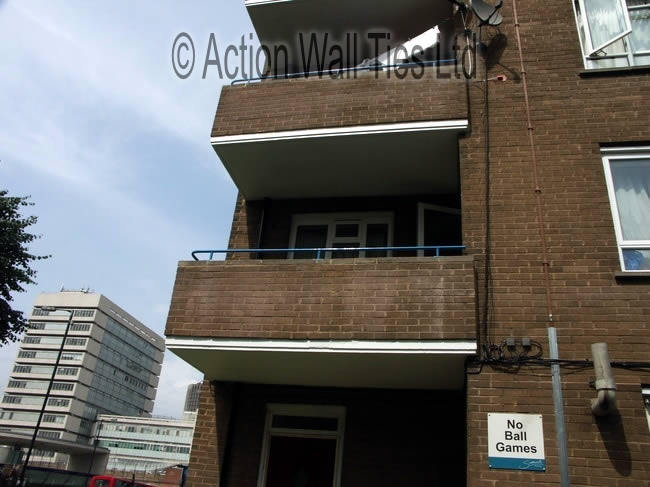

Generally the external bricks and pointing were found to be in good condition with little spalled pointing and spalled bricks noted.
There was visible cracking and previous repairs in a similar pattern to the internal render finish, and cracking to the coping stone and first two courses in line with the embedded steel baluster.
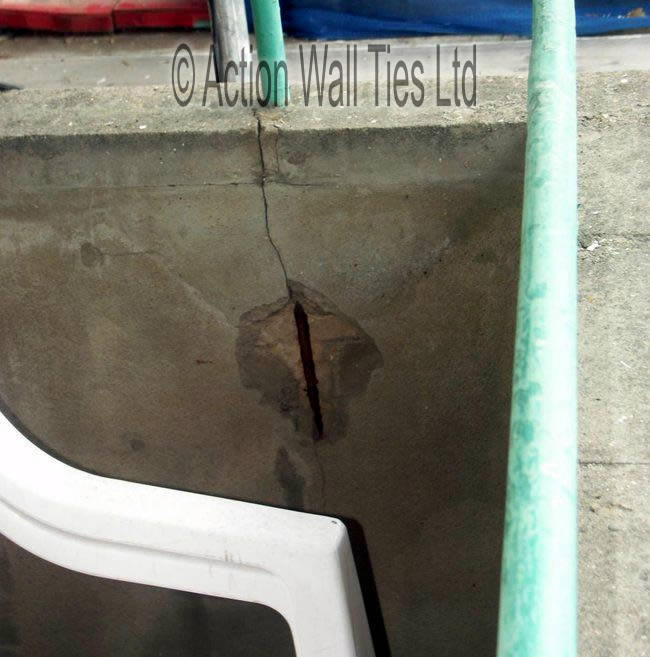
Action Wall Ties’ inspection revealed a heavily corroding 10mm mild steel reinforcing bar, set into the concrete slab adjacent to the brickwork and fixed to the brickwork with mild steel wire ties bent round the upright bar and built into the brickwork bed joint.
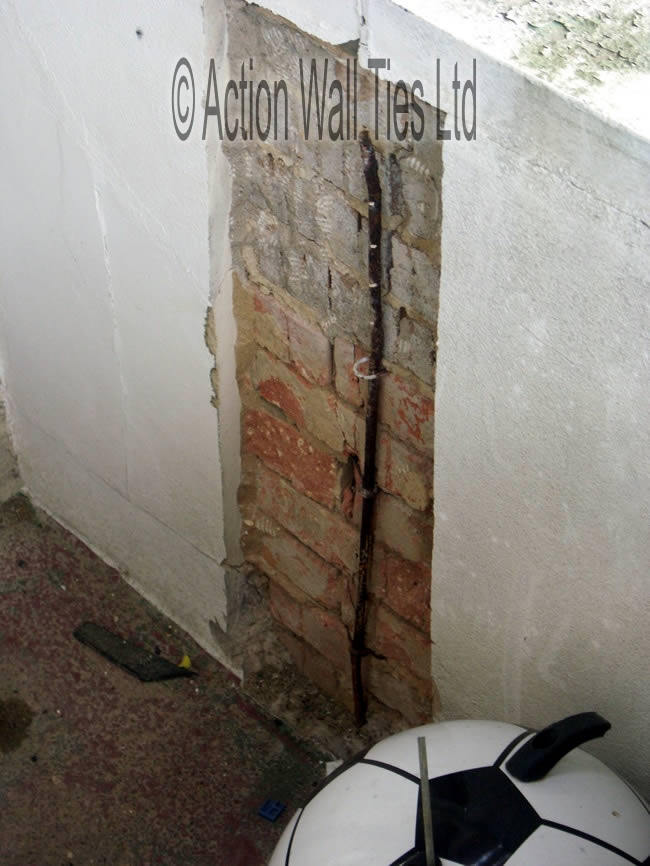
The cracking and previous repairs noted corresponded with the reinforcing bars built into the render finish.
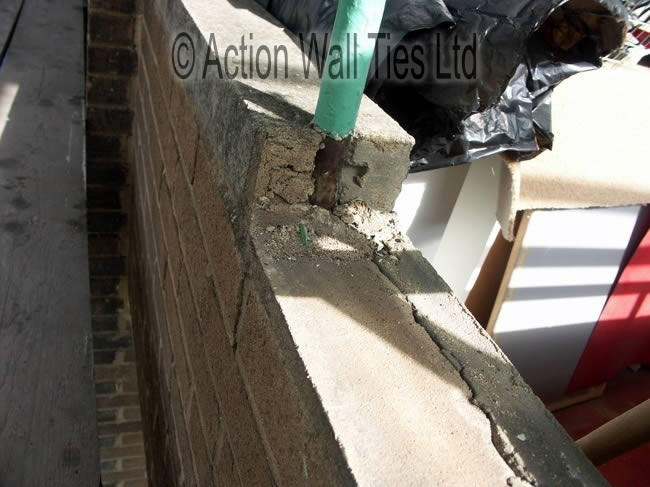
In line with the embedded tubular handrail baluster some cracked bed joints and dislodged coping stones were noted.
In some cases the cracking continued down through the first two courses of brickwork, in line with the depth of the embedded baluster. The coping stones have no mechanical fixing required by modern day standards.
From Action Wall Ties’ findings it is apparent that the cracking to the render finish and cracking to the coping stones and brickwork noted above were due to two generic defects – that of the advanced expanding corrosion to each of the embedded reinforcing bars and the handrail tubular baluster.
The brickwork has admitted moisture, resulting in expanding corrosion (i.e. the formation of ferrous oxide that expands several times the thickness of the metal it has resulted from) on the embedded mild steel, thus cracking brickwork and further fuelling the process by reducing the section of reinforcing bar and the effectiveness of the reinforcing bars.
The ½ brick thick balustrade wall’s lateral stability is dependent on this reinforcement.
The brickwork has admitted moisture running down from the baluster into the masonry resulting in expanding corrosion to the mild steel baluster, thus cracking the brickwork and dislodging the coping stones further fuelling the process.
From our findings an engineering appraisal and remedial strategy was adopted.
The judgment was to determine the extent of the remedial works that should be instigated to accommodate a maintenance program and safety issues assessment.
Action Wall Ties’ remedial works were designed to provide a cost effective, long term repair solution ameliorating all the defects noted, retaining the existing appearance with the minimum of disruption to occupants and impact on the environment.
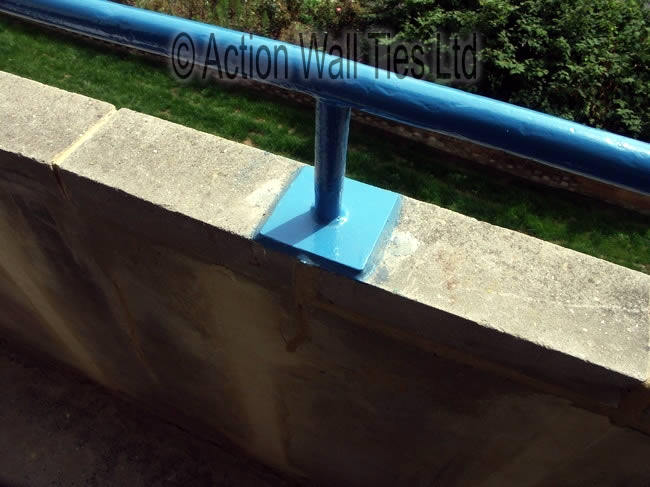
Our proposed remedial scheme provided a viable repair with the introduction of a combination of single corded bed joint reinforcement – to remove the handrail and baluster from the brickwork, drill for and grout in AWT designed stainless steel fixings, cut and weld original handrail in place.

AWT Diamond drilled the full height of the balustrade wall into the concrete slab and injected grouted stainless steel pins, removing the existing reinforcing bars from the brickwork and made good the render, drilled for resin bond stainless steel ties and made good coping stones.
Action Wall Ties (AWT) are specialists in masonry reinforcement and repair, replacing corroded embedded steel and re rendering the surface, providing professional solutions to a wide variety of structural problems in the south east including Kent and London. Contact us on 01227 721 255, or email us.
Our specialist structural repair contractors will be happy to help provide a comprehensive and permanent repair to your structural problems.





